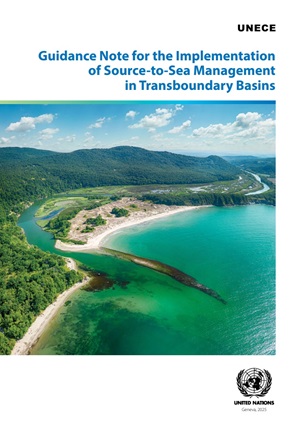The first Guidance Note for the Implementation of Source-to-Sea Management in Transboundary Basins has been released. The publication includes over 25 real-world case studies from Europe, Asia, Africa, and the Americas, providing practical examples of how source-to-sea management can address challenges such as water scarcity and pollution, biodiversity loss and ecosystem degradation, as well as the impacts of climate change.
About 80% of marine pollution originates on land and is carried downstream into the ocean, with far-reaching impacts. This can harm fisheries, tourism, and communities hundreds of kilometers downstream. A connected approach is therefore essential to address the complex challenges that span terrestrial, freshwater, coastal, and marine ecosystems.
The publication offers a roadmap for applying the source-to-sea approach in transboundary contexts. It provides tools and recommendations to strengthen cooperation between upstream and downstream actors, improve ecosystem resilience, and align natural resource management across sectors and borders. It also provides a practical pathway to help countries overcome sectoral divides and jointly manage shared waters from source to sea.
Designed for government officials, river basin authorities, regional seas commissions, and technical practitioners, the Guidance represents a valuable resource for those managing shared waters and interconnected ecosystems such as deltas, estuaries, and marine areas.
The Guidance builds on the growing global momentum for source-to-sea management, reinforced during the 2025 UN Ocean Conference (Nice, 9–13 June 2025), where the Guidance’s main messages were presented.
“The benefits of source-to-sea management can include environmental benefits such as restored aquatic habitats or increased carbon sequestration, social benefits such as reductions in waterborne diseases or greater social cohesion, and economic benefits such as increased fisheries value or a more attractive tourism industry” said Sonja Koeppel, Secretary of the Water Convention. “It can also facilitate peace and security benefits by strengthening regional integration and reducing political tensions through increased coordination on shared objectives.”
The Guidance supports governments, river basin organizations, Regional Seas Commissions and Action Plans, civil society, and the private sector in implementing source-to-sea management, turning shared principles into concrete action and building more coherent, integrated governance of water resources across borders.
The Guidance for the Implementation of Source-to-Sea Management in Transboundary Basins was developed under the Convention on the Protection and Use of Transboundary Watercourses and International Lakes (Water Convention), administered by the United Nations Economic Commission for Europe (UNECE).
It was developed under the leadership of Estonia, Panama, and Slovenia, with support from the Water Convention Secretariat, a lead expert, and a drafting group.

